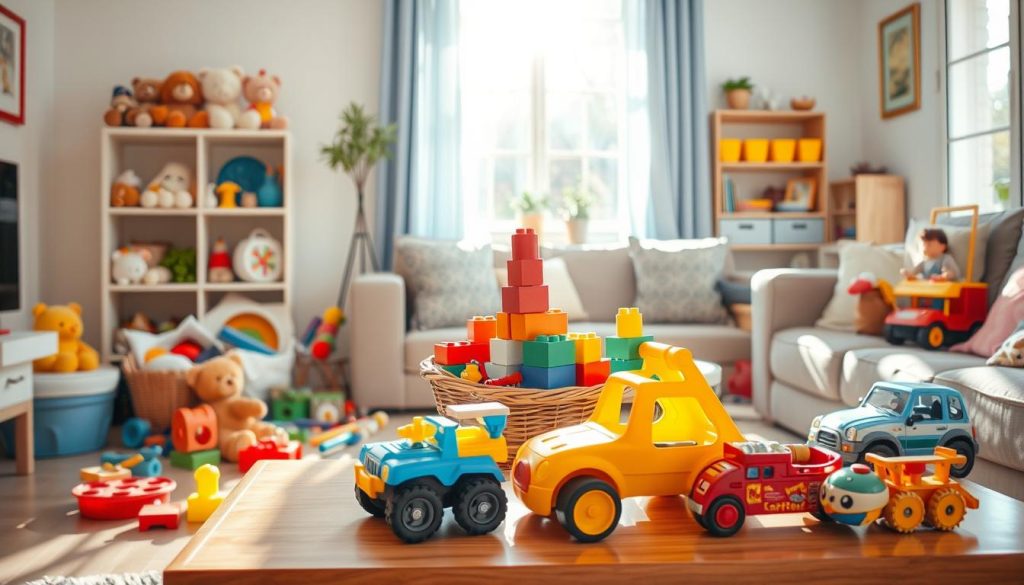As parents, it’s our duty to make sure our kids play with toys that are safe and clean. It’s important to know the right way to clean toys. This keeps germs away and helps toys last longer. The American Pediatric Association says keeping kids’ play areas clean is vital for their health.
Reports show that how we clean toys affects their look and strength. Choosing the correct cleaning method is key to keep the toy in good shape without harming it. Also, the National Safety Council found that different toy materials like plastic, rubber, and wood need certain cleaners. Knowing this helps us clean toys in the safest way possible.
Key Takeaways
- Safe cleaning methods help preserve the integrity of toys.
- Maintaining toy cleanliness is essential for children’s health.
- Different materials require specific cleaning techniques.
- Proper toy care can prolong the life of playthings.
- Expert advice from sources like the American Pediatric Association is valuable.
Understanding the Importance of Toy Cleaning
Keeping children’s toys clean is very important for their health and happiness. Toy sanitation stops harmful bacteria and viruses from spreading.
Health Risks of Dirty Toys
The Environmental Protection Agency (EPA) warns that dirty toys can carry dangerous germs. E. coli, Staphylococcus, and streptococcus can build up, posing health risks. The Centers for Disease Control and Prevention (CDC) also say that toys can keep cold and flu viruses alive, which might make kids sick more often.
Benefits of Regular Cleaning
Cleaning toys the right way gets rid of bad germs and makes toys last longer. The Pediatrics journal says this means kids get sick less in clean play areas. The American Journal of Play adds that clean spaces also make kids feel better mentally, making playtime more fun and safer.
Types of Toys and Their Cleaning Needs
Cleaning toys the right way helps them last longer and keeps them safe. Different toys need different cleaning methods. Advice from toy leaders like Hasbro and Mattel, and The Toy Association’s guidelines, can help.
Soft Toys and Plushies
Soft toys and plushies need to be cleaned carefully to stay looking good and clean. Most can go in the washing machine, but always check the label first. Use a gentle cycle, a mild soap, and a mesh laundry bag.
For those that can’t be machine washed, spot cleaning works well. Pick a cleaner that’s safe for fabric to keep the toy in top shape.
Plastic and Rubber Toys
Plastic and rubber toys are easy to find in homes. They should be cleaned regularly to kill germs. Use mild soap and warm water for most of these toys.
The Toy Association reminds us to rinse toys well to remove all soap. Toys must be dry before you put them away to stop mold and mildew from growing. This step is key.
Wooden Toys
Wooden toys need a different cleaning method to prevent damage. The Smithsonian’s experts recommend wiping them with just a bit of water and gentle soap. Dry them right away.
Keep wooden toys in great condition by oiling them with a food-safe product. This helps your clean toys stay safe and looking their best.
| Type of Toy | Cleaning Method | Key Considerations |
|---|---|---|
| Soft Toys and Plushies | Machine wash on gentle cycle or spot clean | Check manufacturer instructions, use mesh laundry bags |
| Plastic and Rubber Toys | Wash with mild soap and warm water | Thorough rinse, ensure complete drying |
| Wooden Toys | Wipe with a damp cloth, minimal water | Dry immediately, avoid excessive moisture |
Effective Cleaning Techniques
It’s very important to keep toys clean for kids’ health and the toys’ lifespan. You need the right cleaning method depending on the toy’s material. We’ll show you how to clean toys the right way. Using safe cleaning practices keeps toys germ-free and won’t damage them.

Washing Machine Tricks for Soft Toys
Machine washing soft toys is easy if you follow a few steps. First, look at the care label before washing. Use cold water, a mild detergent, and a gentle cycle. Putting toys in a mesh bag can protect them.
Then, either tumble dry on low or let them air dry. This prevents shrinkage or harm to the toys.
Disinfecting Plastic Toys Safely
Plastic toys need to be cleaned carefully to avoid damage. Start by rinsing off any dirt with warm water. Mix water with a gentle disinfectant, like a diluted bleach solution suggested by Clorox, and clean them well. Remember to rinse thoroughly and let them dry completely before kids play with them again.
Cleaning Wooden Toys Without Water
Wooden toys can’t get too wet because it ruins the wood. Just use a slightly damp cloth and a bit of soap for cleaning. Never soak or dip them in water. For a deeper clean, a wood-safe product is best. After cleaning, make sure they’re completely dry to stop warping or damage.
| Type of Toy | Recommended Cleaning Method |
|---|---|
| Soft Toys | Machine wash on gentle cycle with mild detergent; air dry or low tumble dry |
| Plastic Toys | Rinse with warm water; disinfect with a safe solution; air dry |
| Wooden Toys | Wipe with a damp cloth and mild soap; avoid soaking; dry thoroughly |
Best Cleaning Products for Toy Care
Choosing the right cleaning products is key to keeping children’s toys safe and long-lasting. Knowing how to clean toys correctly helps parents keep play areas clean.
Safe Household Cleaners
It’s crucial to pick household cleaners that are safe and effective for cleaning toys. The Environmental Working Group offers a great database to find the right products. You can clean most toys with mild dish soap, white vinegar, and baking soda. These items are safe and easy to find.
Commercial Toy Cleaning Solutions
Some products are made just for cleaning toys. Good Housekeeping suggests brands like Seventh Generation and Babyganics because they are safe and work well. These products are made to clean thoroughly while being safe for the toys.
DIY Natural Cleaning Remedies
For a natural method, try making your own cleaners. Martha Stewart Living recommends water with white vinegar or a baking soda paste. These homemade cleaners are safe, green, and good for parents who care about the environment.
| Product Type | Examples | Benefits |
|---|---|---|
| Safe Household Cleaners | Mild Dish Soap, White Vinegar, Baking Soda | Non-toxic, readily available, cost-effective |
| Commercial Toy Cleaning Solutions | Seventh Generation, Babyganics | Formulated for toys, convenient, effective |
| DIY Natural Cleaning Remedies | Water and Vinegar, Baking Soda Paste | Eco-friendly, safe, gentle on toys |
Tips for Maintaining Toys After Cleaning
After cleaning, keeping toys clean and safe is vital. It helps them last longer and stay safe for kids. To do this, proper storage, checking toys often, and teaching kids about toy care are vital. These steps keep toys in great shape.
Proper Storage Solutions
Correctly storing toys cuts down on dust and stops moisture problems. The Container Store’s experts say use airtight containers and bins that can be reached easily. This makes sure toys stay dry and clean. Their condition and cleanliness last longer this way. Also, sorting toys by type makes cleaning up faster and better.
Regular Inspection and Maintenance
Checking toys often is key to finding any wear and tear or dangers. The U.S. Consumer Product Safety Commission advises looking for broken or loose parts that could be unsafe. Fixing toys quickly keeps them safe and working well. Adding toy cleaning and fixing to a monthly plan helps keep toys like new.
Educating Kids on Toy Care
Teaching kids to look after their toys teaches responsibility and cleanliness. Sesame Workshop highlights the value of showing kids simple cleaning tasks. Like wiping their toys and putting them away after use. This not only keeps things clean but also teaches respect for their stuff. Making toy care a regular thing helps kids learn to keep their play areas clean and tidy.

